#Funerary monument
Explore tagged Tumblr posts
Text
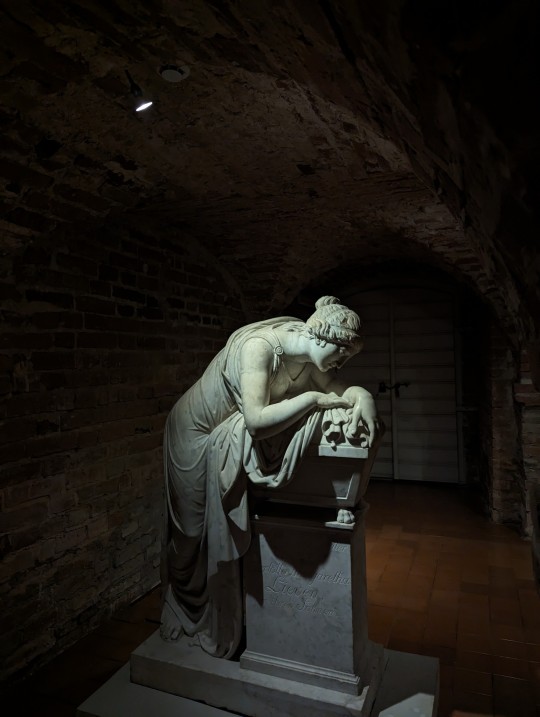
Funerary monument in Rundāle Palace, Latvia
#art history#art#sculpture#rundāle palace#funerary art#funerary monument#monument#marble#marble sculpture#mourning#latvia#artist#baroque#roccoco#neoclassicism#dark academia
17 notes
·
View notes
Text


Today's Flickr photo with the most hits: this detail from the Sarcophagus of the Spouses. This Etruscan funerary monument is housed in the Villa Giulia, Rome.
1 note
·
View note
Text

SO this! is about this specific entry in Burchard's Diary--

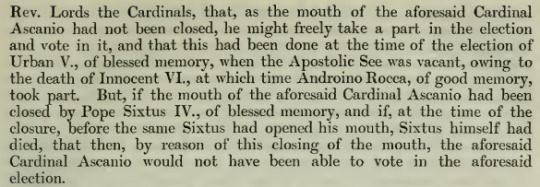
The Diary of John Burchard, trans. A. H. Mathew
--and the APERITIO ORIS rite (the mouth thing they keep talking about), but it's also a little about Ascanio's friction with the Vatican and the della Rovere-Ascanio rivalry

Politics and Dynasty: Underaged Cardinals in the Catholic Church, Jennifer Mara DeSilva

Popes, Cardinals and War: The Military Church in Renaissance and Early Modern Europe, David Chambers

Ascanio Maria Sforza: la parabola politica di un cardinale-principe del Rinascimento, Marco Pellegrini
#ascanio sforza#giuliano della rovere#italian renaissance tag#the thing about long term rivals is eventually you know each other better than lovers ever could bc you've spent so much time#trying to shove each other down a flight of stairs. there was.#christ what was it. della rovere's price of reconcilliation with rodrigo was kicking ascanio out of the vatican. something like that#literally you could've asked for anything and you picked the head of ascanio sforza. that's commitment baby.#marriage vows have NOTHING on that. but ofc. they did reconcile. and della rovere did visit him daily to talk for that one summer#ALSO THE FUCKING FUNERARY MONUMENT DELLA ROVERE COMMISSIONED#WHAT'S WITH THE ROMANTIC NECROMANCY BUDDY. HELLO? HELLO. BANGING ON THE VATICAN DOORS. ANSWER ME!!!!#drawing tag
473 notes
·
View notes
Text

Roman Funerary Altar Found in Italy
Buried in a rocky riverbed in northern Italy sat a forgotten ancient artifact. The artifact certainly wasn’t intended to be forgotten. It was too big and ostentatious for that. But the waterway and the passing centuries had prevailed over the ancient stone.
Not anymore.
Ervino Silvestri spotted the ancient artifact in the gravel of the Torre river in San Vito al Torre and alerted officials, the Superintendency of Archaeology, Fine Arts and Landscape of Friuli Venezia Giulia said in a Feb. 22 news release.
Archaeologists excavated the riverbank and unearthed a massive block of carved limestone. They identified it as an ancient Roman funeral monument.
The monument weighed about 13,000 pounds, archaeologists said. One corner of the rectangular monument was chipped, but the rest was generally intact.
One end had a carved figure of Erotes holding a torch and poppy flower, symbols of eternal sleep or death, officials said. A photo shows the figure inside a carved frame.
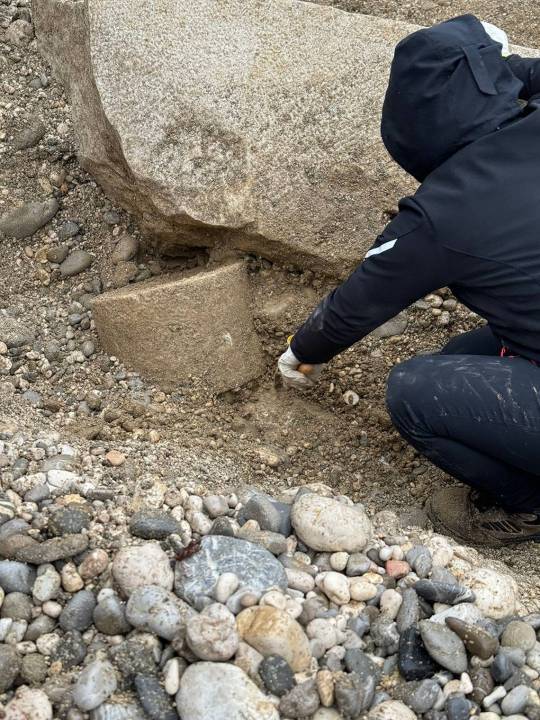
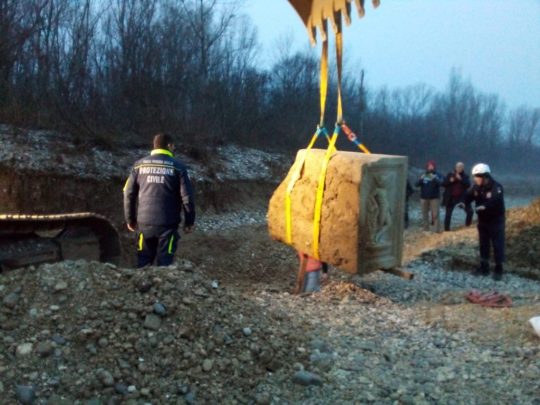
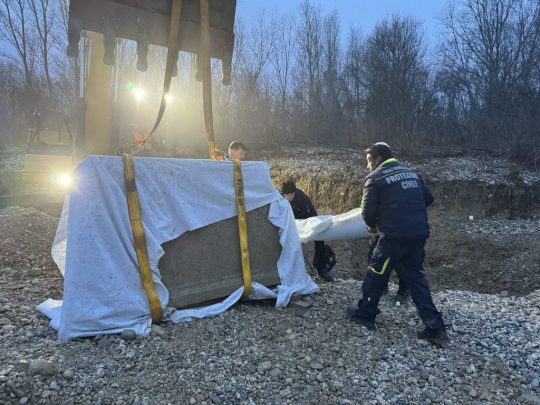
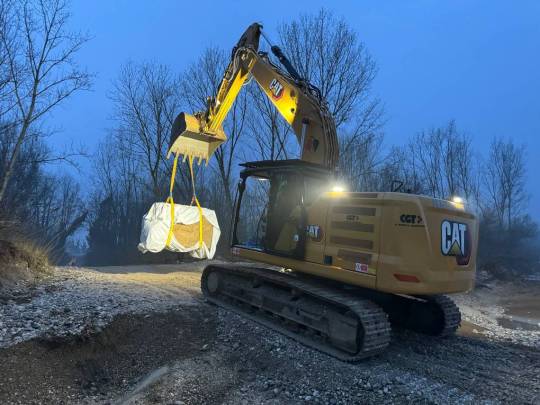
Erotes was a figure of ancient Roman mythology comparable to Cupid or Eros, according to Britannica. Although generally the god of love, Eros could represent different symbols in different contexts.
Archaeologists also found an inscription on the ancient Roman monument but did not provide a translation.
The decoration style indicated the monument was from the high imperial era. Archaeologists did not give a specific date range, but, according to National Geographic, ancient Rome’s imperial era lasted from 27 B.C. to 476 A.D., peaking in 117 A.D.
The stone monument was so heavy that an excavator was needed to move it, officials said. Photos show this process. The artifact was placed in a temporary shelter for cleaning and further study.
Excavations of the gravel riverbed also uncovered a stone urn, a limestone carving of a man’s face, other limestone artifacts, bricks and tile pieces, archaeologists said. Photos shared by officials in a Feb. 22 Facebook post show some of these finds.
San Vito al Torre is about 300 miles northwest of Rome and near the Italy-Slovenia border.
By Aspen Pflughoeft.
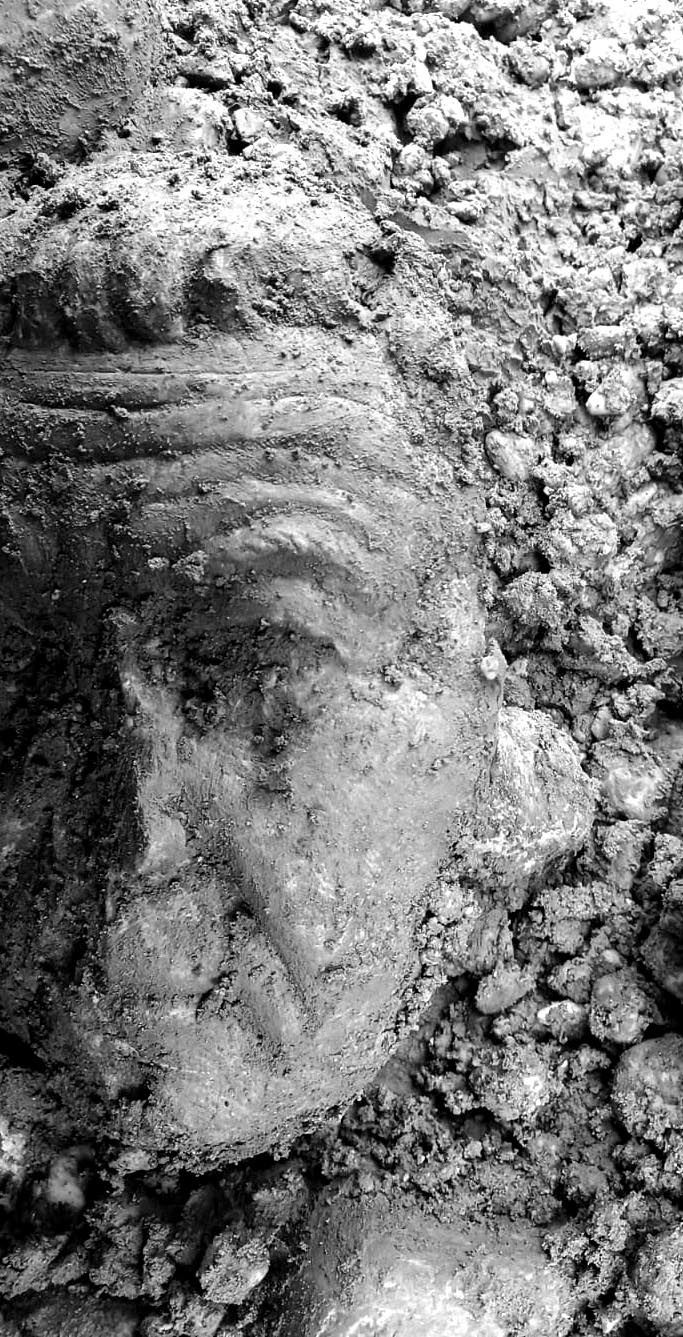
#Roman Funerary Altar Found in Italy#Torre river in San Vito al Torre#carved limestone#Roman funeral monument#ancient artifacts#archeology#archeolgst#history#history news#ancient history#ancient culture#ancient civilizations#roman history#roman empire#roman art
68 notes
·
View notes
Text

Calcagno family monument, Staglieno Cemetery, Genoa, Italy, by Adolfo Apolloni, 1904. A bronze masterpiece statue lying on the steps, deposing a last flower on the grave; the personification of sorrow. Date: circa 1905
2 notes
·
View notes
Text

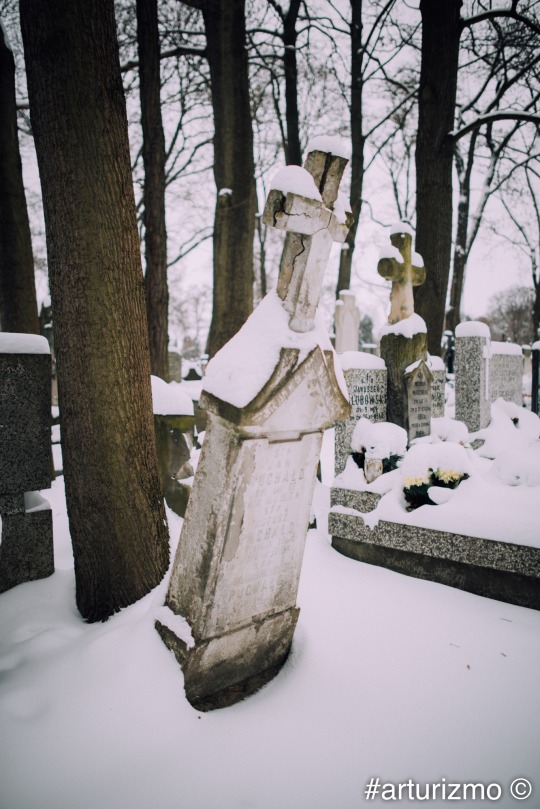





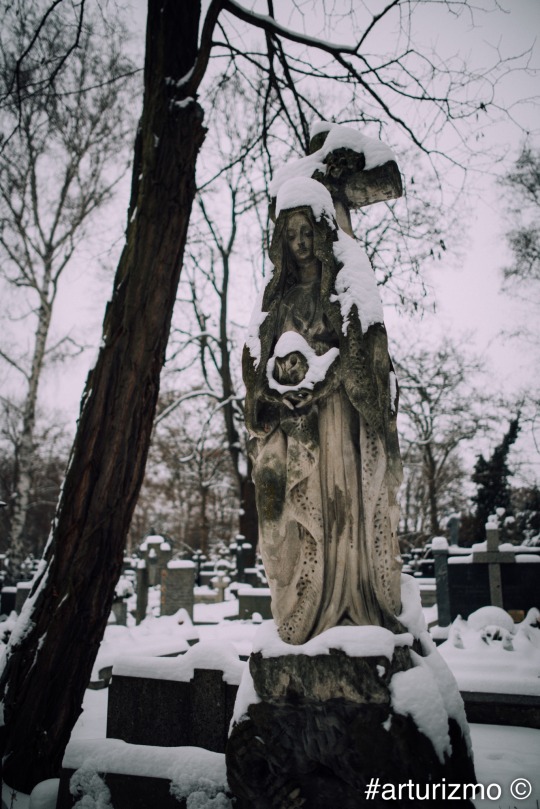
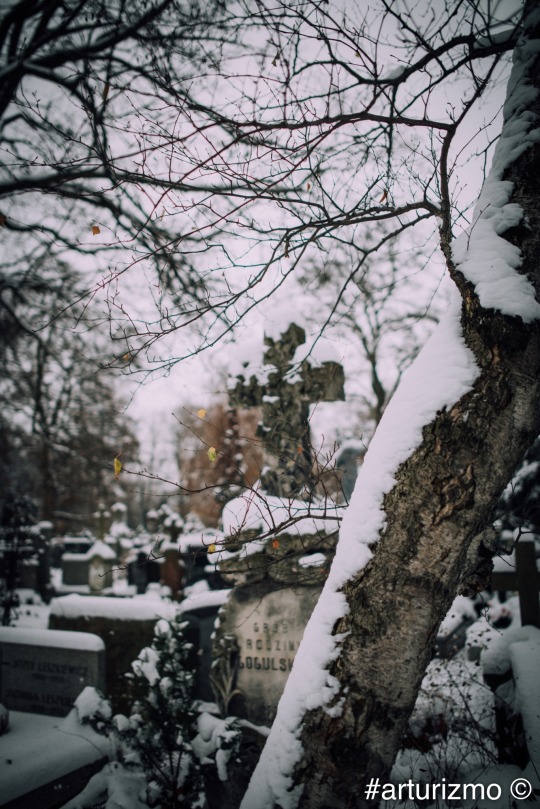
instagram
Light a match 🔥❄️
#winter#cemetery#monument#funerary#fire#silence#nikon photography#nikon#nikon d610#photographers on tumblr#original photographers#photography#arturizmo
50 notes
·
View notes
Text

love this etruscan funerary monument of adonis dying 1. because theres a cute doggie 2. he looks exactly like i do when my alarm goes off in the morning
342 notes
·
View notes
Text

Funerary monument of the Dossi Rampinelli Spalenza family by Giovanni Battista Lombardi (ca. 1856) at Monumental Cemetery in Brescia, Italy
207 notes
·
View notes
Text
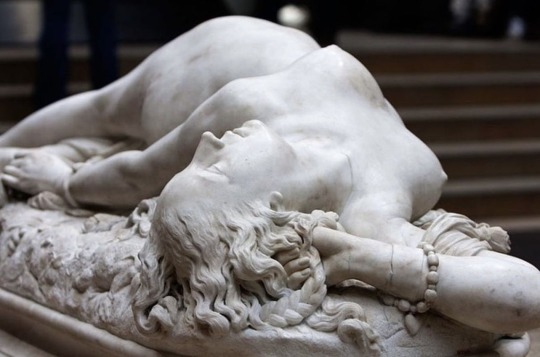

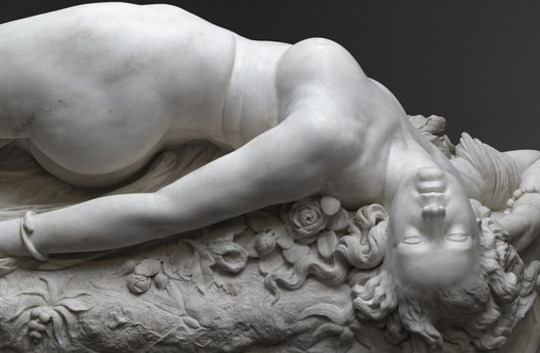


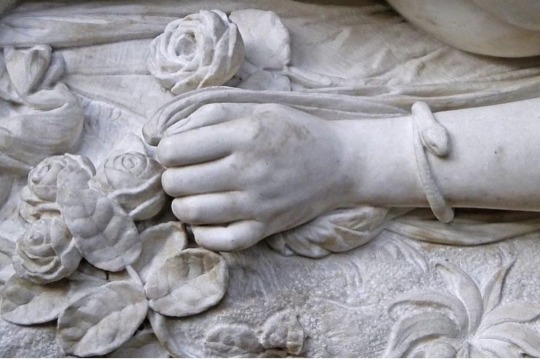


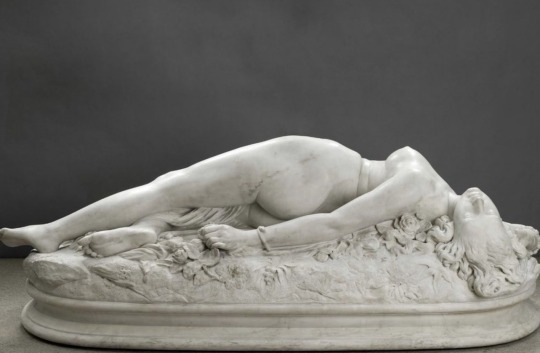

Woman Bitten by a Serpent, by Clésinger…...
This captivating marble carving caused a great scandal in the 1847 Parisian Salon. A suggestive image of a naked woman writhing from the pain of a bite inflicted by the snake twisted around her wrist, or that may be just a cover story for something else? Scandalous like few, critics claimed that this masterpiece was produced from a life cast of the commissioner's mistress, Apollonie Sabatier
- also muse to Baudelaire and known as "La Présidente" - as to claim the artist was lazy, unskilled and immodest, and pointed to the dimpled flesh at the top of her thighs to strengthen their point. Proof that there is no such a thing as bad publicity, Clésinger had his friend Theophile Gauter orchestrate the scandal to grow the sculpture's success.
Auguste Jean-Baptiste Clésinger
(1814-1883) was a painter and sculptor known for the sensuality of his works. Trained by his father, also a celebrated sculptor belonging to the Besancon school of painting, he began exhibiting in the Parisian Salon in 1843 and earned immediate success. He produced plenty of acclaimed busts, such as those of Rachel Félix, Louis of Savoy and his dear friend Theophile Gautier.
His works are displayed in places of the highest distinction such as the Jardin du Luxembourg and the Musee d'Orsay in Paris, and was much admired for the funerary monument of Chopin in the Pere Lachaise Cemetery, where he is buried himself, along with many others. After a failed marriage he met his model and mistress Berthe de Courrière, to whom he was still devoted until the end of his life. He received the Légion d'honneur in 1849.
• Height: 56,5 cm (22.2 in). Width: 180 cm (71 in). Marble, 1847.
fIr Musée d'Orsay, Paris.
#art#beauty#photography#vintage#black and white#60s style#the paradigm web#painting#abstraction#nude figure
331 notes
·
View notes
Text
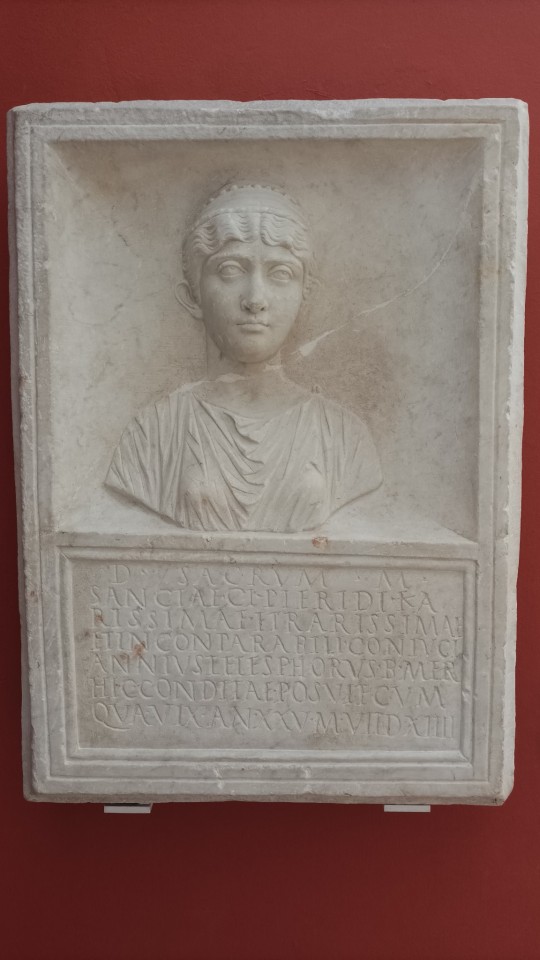
The museum sign for this inscription simply said 'funerary monument to Pieris'. What it didn't say is that she was karissima. Rarissima. Incomparabilis. It forgot to mention that someone loved her very much and wanted everyone to know it.
611 notes
·
View notes
Text

Today's Flickr photo with the most hits: this donkey chowing down on Nemrut Dag. The photo was taken in 2006; Peter and I went to see the monumental funerary temples of Antiochus I, atop the mountain.
0 notes
Text

‘enamel box painted with […] the admiral mourning by a monument to his fate’ what’s he doing at his own fictional funerary monument
195 notes
·
View notes
Text
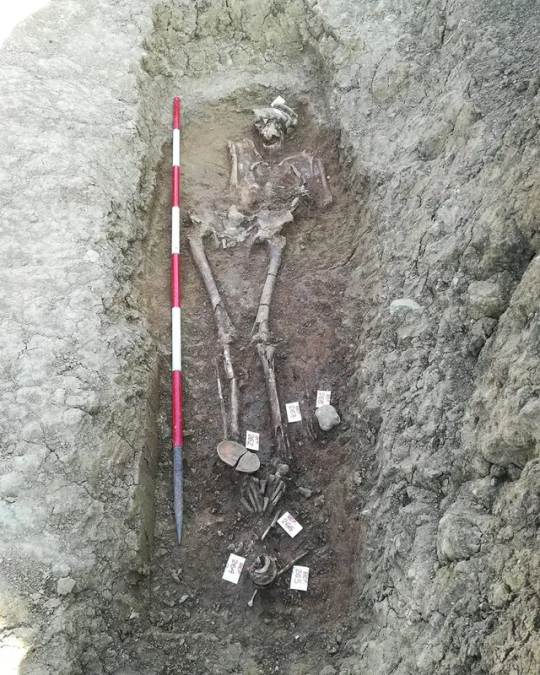
Imperial Roman Necropolis Found in Sicily
Archaeologists with the civil engineering company Italferr have unearthed a Roman settlement and necropolis during the construction of the new Palermo-Catania-Messina railway link in Sicily.
Located on a hill overlooking the Dittaino River, this Roman settlement dates back to the mid-1st to the 3rd century CE. The site’s strategic position, offering control over the Dittaino Valley and key communication routes, underscores its importance during its time.
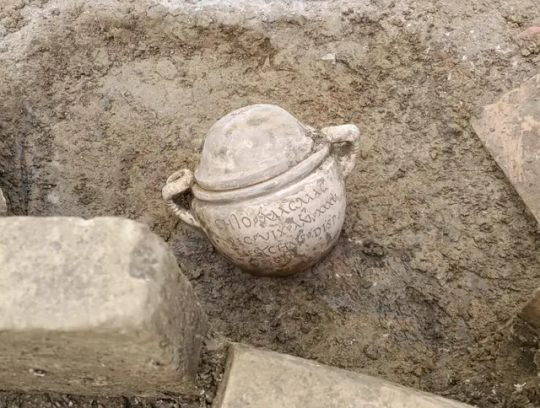
Excavations have revealed a well-organized rustic villa complex, known as a villa rustica, which was central to the settlement’s agricultural and livestock activities. The villa’s central room, flanked by three ambulatories, has been identified through traces of collapsed roof materials. The villa’s remains indicate not only a residential function but also a productive role, likely linked to the region’s agricultural economy. Remnants of pavements and collapsed structures further emphasize the villa’s significance.
To the west of the settlement lies an extensive necropolis with 168 burials, showcasing a highly stratified society. The burials range from simple earth pits covered with tiles to monumental tombs, indicating significant social diversity within the community.
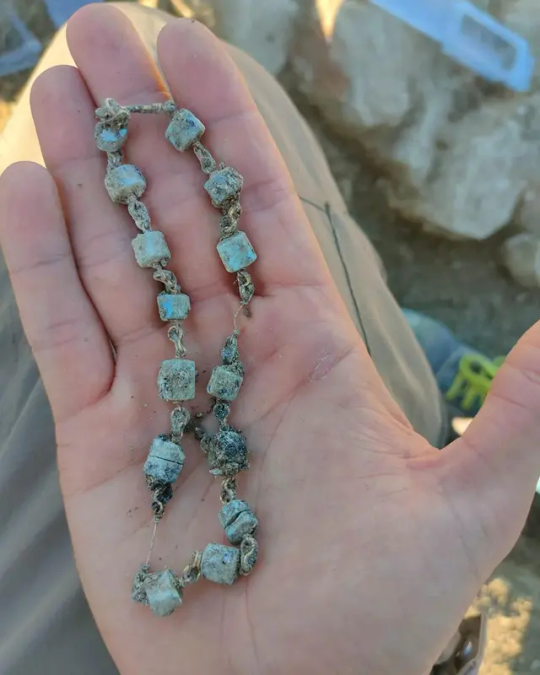
Among the notable graves is a bastum, or mound grave, which contained exceptional funerary offerings, including five necklaces, two gold rings, and a cinerary urn made from Carrara marble.
The urn bears an inscription dedicated to a “Magnus Magister Pecoris,” an official responsible for overseeing sheep breeding, and another inscription mentioning a “dispensator” who donated the urn to the deceased.
Magnetometric surveys to the east of the settlement have identified a possible cult area. Archaeologists found traces of burnt animal bones, ash layers, and alluvial deposits in a natural channel, indicating ritual activities. Among the recovered objects are oscilla masks, bone needles and pins, and a die with an undeciphered inscription. These artifacts suggest the performance of rituals and offerings to various deities in connection with festivals and ceremonies.
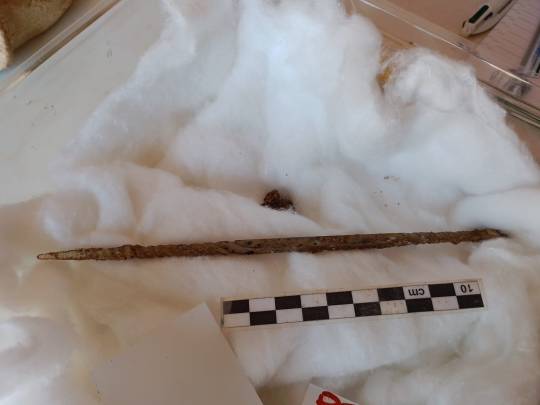
Italferr, a company under the Ferrovie dello Stato Italiane Group, has been at the forefront of integrating archaeological expertise with modern engineering practices since the 1990s. The company’s proactive approach to preventive archaeological investigations has proven instrumental in preserving cultural heritage while advancing infrastructure development.
The excavations at the Palomba-Catenanuova section began in 2020 in collaboration with the Soprintendenza Beni Culturali e Ambientali di Enna.
By Dario Radley.

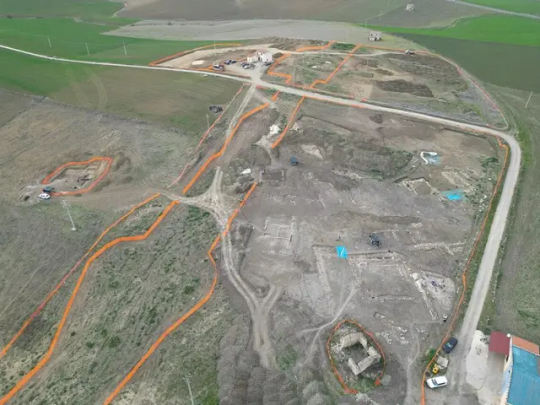
#Imperial Roman Necropolis Found in Sicily#Dittaino Valley#ancient tomb#ancient grave#ancient necropolis#ancient artifacts#archeology#archeolgst#history#history news#ancient history#ancient culture#ancient civilizations#roman history#roman empire#roman art#ancient art
188 notes
·
View notes
Text

“Horse Rock,” Beyşehir, Konya Province, Anatolia, Turkey,
The Tomb of Lukuyanus from 2000 years ago, is dedicated to a beloved jockey who was likely buried in the “grave room”, a small chamber next to the horse relief with a columned entrance.
The grave room is devoid of remains now so we don’t know much about Lukuyanus other than what’s on the inscription: “Lukuyanus The Warrior, Died Before Getting Married. He is Our Hero.”
Since he died before marriage, he was likely a young man when he met his end, but he lived long enough and had enough success on the track to earn him dedicated fans who built him such a handsome and on-topic final resting place.
Fan-funded funerary monuments for sports heroes have proved rich sources of historical information before.
The monument is near the site of an ancient hippodrome in mountains that were sacred to the Hittites. The Romans may even have built a hippodrome on this spot to bless and be blessed by the Hittites’ holy hills.
#art#history#design#style#archeology#sculpture#antiquity#jockey#hero#tomb#grave#turkey#warrior#hittite#lukuyanus#monument
104 notes
·
View notes
Text



The Grave with the Hands (Dutch: Graf met de handjes, lit. 'Grave with the little hands') is a 19th-century funerary monument in the Dutch city of Roermond. It comprises two almost identical tombstones on either side of a wall separating the Catholic part from the Protestant part of Begraafplaats Nabij de Kapel in 't Zand (Cemetery Near the Chapel in the Sand), each with a carved arm and hand that clasps the other across the wall. The monument marks the graves of Josephina van Aefferden, a Catholic, and Jacobus van Gorkum, a Protestant, who were married in life, but had to be buried in separate sections of the cemetery.
The marriage was controversial for many reasons: van Gorkum was Protestant and van Aefferden was Catholic; their families had fought on opposite sides of the recent war; he was 11 years older than she was; and he was a commoner while she was of noble birth.
The two hands, a man's hand from his monument, clasping a woman's hand from hers, symbolize the connection between the spouses across the boundaries of religion, family alliances and even death.
117 notes
·
View notes
Text
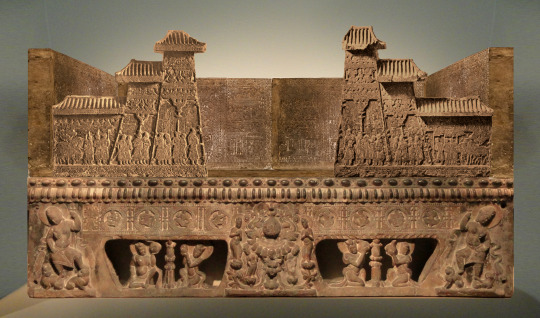


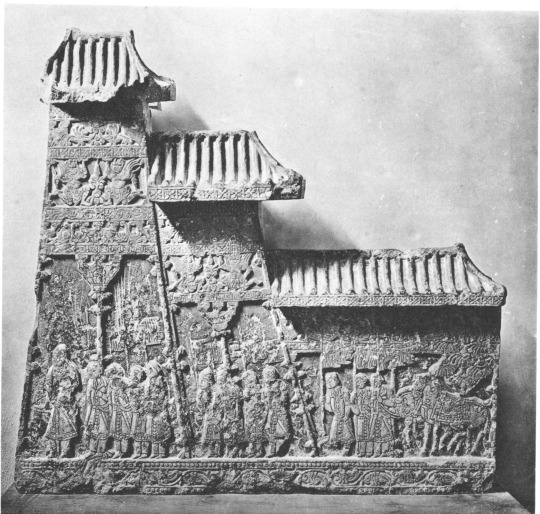







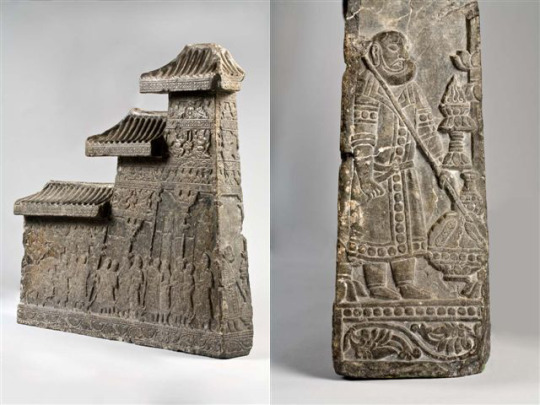
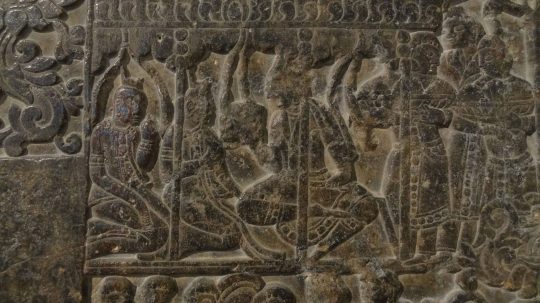

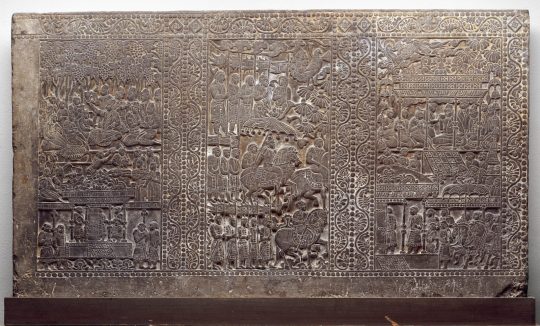

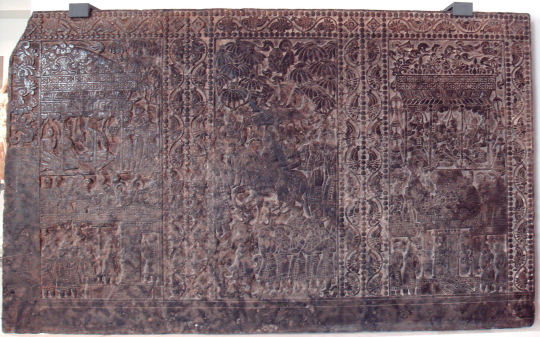

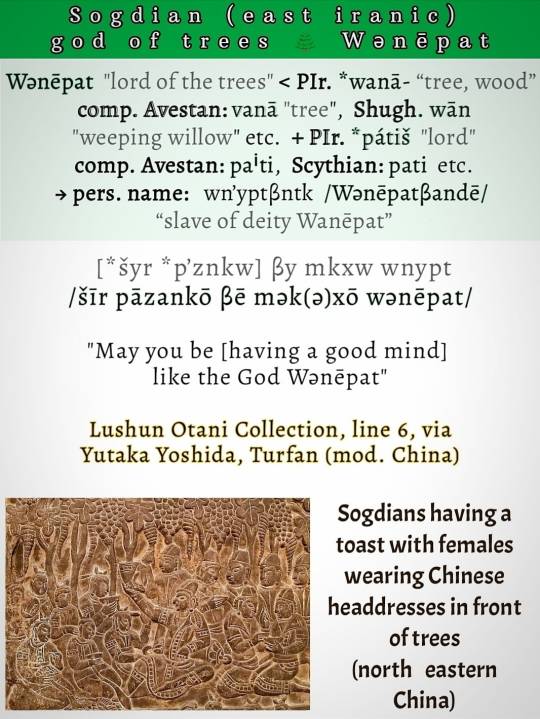
Anyang funerary bed 550-577 CE
"The Anyang funerary bed (Chinese: 安阳北齐石棺), also known locally as the Bed of Ts'ao Ts'ao (from the Chinese hero Cao Cao), is a Chinese funerary couch belonging to a Sogdian merchant and official active in China in the 6th century CE. The tomb was discovered in 1911, and the components of the funerary bed were dispersed among various museums in the world after being offered on the art market. It is thought the funerary bed was excavated in Anyang (ancient Zhangdefu), capital of the Northern Qi dynasty. It is stylically dated to the Northern Qi dynasty (550–577 CE).
There are eight known components of this funerary monument: a dais and two cornices with notched ends, now in the Freer Gallery of Art, a pair of gates, now in the Museum of East Asian Art (Cologne), two rectangular slab in the Boston Museum of Fine Arts, and one slab in the Guimet Museum in Paris.
The funerary bed is important to Sogdian art and culture, as it is decorated with musicians in the typical Sogdian attire and with a Buddhist scene including deities. The ensemble of Sogdian musicians includes two lute players, a flutist, two drummers and a cymbal player, as well as two dancers. Two stretchers once attached to the bed showed what the Chinese called a huxuan wu (胡旋舞), i.e. "Sogdian Whirl dance", which was enormously popular in China, and appears on many Chinese tombs. Tang sources confirm the dance's popularity. It was performed at court by the Tang Chinese emperor Xuanzong and his favorite concubine.
Gustina Scaglia was the first to recognize in 1958 that the pieces scattered in several museums belonged to a single funerary couch made for a member of the Sogdian community in China.
The owner and exact history of the owner of the tomb remain unknown, as the epitaph has been lost.
Sogdian stone funerary beds disappear during the subsequent Tang dynasty period, even though Sogdian influence was probably even more significant in China at that time, possibly due to Imperial restrictions regarding funerary practices."
-taken from Wikipedia
#sogdiana#ancient history#art#antiquities#history#sculpture#statue#museums#archaeology#ancient china#antiquity#anthropology
245 notes
·
View notes